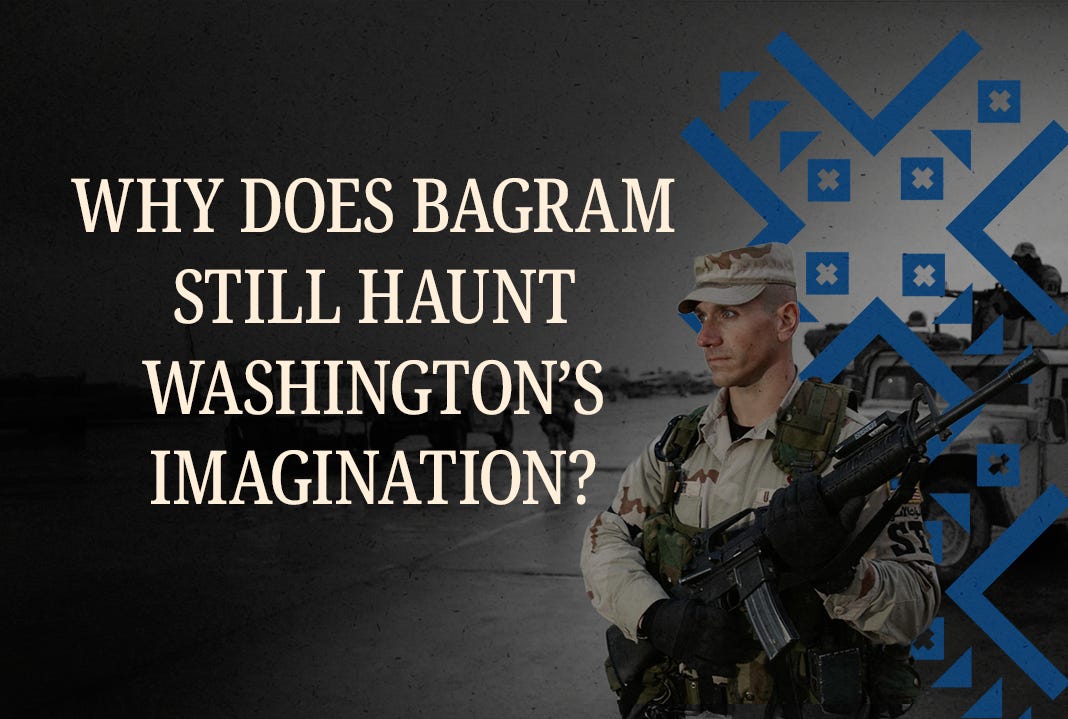Why Does Bagram Still Haunt Washington’s Imagination?
From Beijing to Moscow to Tehran, every major power sees opportunity in the airbase the U.S. left behind. For Washington, Bagram’s loss is less about the base itself than America's narrowing influence
When Donald Trump said in September that he wanted to take back Bagram, it sounded like another campaign soundbite, but it struck a nerve.
Bagram Air Base, once the largest U.S. installation in Afghanistan, has long been more than a military site. It’s a barometer of global ambition. Each power that occupied it, from the Americans, the Soviets, to even briefly the British, used it to project influence far beyond Afghanistan’s borders.
Trump called Bagram “the best real estate in the region.” And he’s not wrong about its location. The base sits on the flat plains of Parwan Province, 11 kilometers from Charikar. Just north of Kabul, the province is a strategic crossroads linking South Asia, Central Asia, and the Middle East. From Bagram, one can reach Tehran, Islamabad, or Kashgar in a few hours’ flight.
That geography has always been the point.
Bagram was first constructed in the 1950s with American assistance, when Washington and Moscow were competing for influence in Afghanistan’s neutral monarchy. In the 1980s, the Soviets expanded it into a major hub for their air campaign during the invasion. When they withdrew, the base was fought over by mujahideen factions.
After 9/11, U.S. forces captured it within weeks and transformed it into their central headquarters, complete with two runways, a hospital, a prison, and a city’s worth of infrastructure. For nearly two decades, every major operation in Afghanistan was coordinated from Bagram. Its strategic value lay not only in proximity to Kabul but in its ability to host heavy aircraft and surveillance assets.
By the time the U.S. withdrew in 2021, Bagram had become the physical symbol of America’s longest war and, to some, of its overreach. When the Taliban entered the base weeks later, the image of fighters walking through deserted hangars became a shorthand for the collapse of Western policy.
Four years on, the base still matters, not because of what it is, but where it is.
For Washington, Bagram represents lost access to a region where its footprint has shrunk. Since the withdrawal, the U.S. has relied on “over-the-horizon” counter-terrorism from the Gulf, which limits reach and reaction time. A re-established presence in Bagram would place American forces closer to both emerging threats in Afghanistan and strategic competitors like China, Russia, and Iran.
That’s the context behind Trump’s remark. His call to “get it back” is not a plan for re-occupation, but an expression of a broader anxiety: the fear that the U.S. ceded the heart of the region to rivals.
China, meanwhile, has moved in stealthily. Beijing’s companies have acquired mining concessions for copper and lithium, and its diplomats have deepened ties with Kabul’s de facto authorities. For China, Afghanistan is a corridor, part of a network connecting Xinjiang to Pakistan and the Arabian Sea. Bagram, lying roughly 600 kilometers from Chinese territory, holds obvious interest as both a security concern and a potential node in regional trade.
Russia’s calculus is different. Having lost its own war there in the 1980s, Moscow now sees Afghanistan as a buffer zone to manage through diplomacy rather than control through force. Iran, too, watches closely: Bagram’s air corridors once hosted American surveillance flights near its borders, something Tehran would be keen to prevent.
In this web of overlapping interests, Afghanistan is again positioned at the center of a regional competition, not as a prize, but as a platform.
What’s notable about Bagram today is how its meaning keeps evolving. During the Cold War, it was a fortress. During the War on Terror, it was a logistics hub. Now it’s a mirror, reflecting the strategic anxieties of every major world power surrounding it.
For the U.S., the question is less whether it could retake Bagram and more whether it should. The era of massive overseas bases is giving way to lighter, rotational presences and partnerships built on intelligence and technology. The symbolism of Bagram—fixed, monumental, and expensive—belongs to an earlier model of power projection.
Still, its pull endures. To policymakers in Washington, Bagram represents lost influence. To Beijing, it represents a potential surveillance risk. To Kabul’s rulers, it represents sovereignty. And to ordinary Afghans, it remains the most visible relic of two foreign occupations in one lifetime.
Trump’s call may fade, but the logic behind it won’t. As global attention shifts from the Middle East to great-power competition, Afghanistan’s geography will keep drawing new designs onto the same old map. Bagram, perched between empires and economies, will continue to matter, not because anyone needs it, but because no one can quite ignore it.
Middle East Uncovered is powered by Ideas Beyond Borders. The views expressed in Middle East Uncovered are those of the authors and do not necessarily reflect the views of Ideas Beyond Borders.




